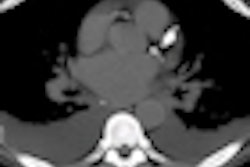A new study from China found that perfusion CT can detect and quantitatively assess microvessel changes associated with liver toxicity in chemotherapy patients. The results could help noninvasively assess early liver damage in cancer patients while obviating the need for a separate scan.
Liver damage is common in cancer patients following chemotherapy, but it's hard to detect. Symptoms are rarely present, liver function tests are frequently normal, and the condition is usually reversible. But even mild toxicity carries a risk of progression to severe liver impairment, creating the need for sensitive and reliable assessment tools.
While early liver damage can't be seen on traditional CT, perfusion CT has been shown to depict hemodynamic changes in living tissue, and it has been used in previous evaluation of liver diseases. However, there have been no reports on microcirculation changes in the liver on perfusion CT images during chemotherapy, wrote Qing Zhang and colleagues from the Shandong Medical Imaging Research Institute, as well as researchers from Affiliated Hospital of Shandong Academy of Medical Sciences and Shandong Academy of Medical Sciences, all in Jinan, China.
"In this study, we investigated the hemodynamic changes in liver during chemotherapy, and estimated the correlation between the perfusion CT parameters and alanine aminotransferase (ALT) levels," wrote Zhang and colleagues (World Journal of Gastroenterology, July 7, 2010, Vol. 16:25, pp. 3202-3205).
They compared three perfusion CT parameters -- hepatic perfusion index, mean transit time, and permeability-surface area product -- among controls, patients, and subgroups, examining 60 consecutive patients with tumors, along with 20 controls.
The 20 controls (12 men, 8 women; mean age, 47.3 ± 8.6 years; range, 35-64 years) had no evidence of liver disease in assessments that included physical exams, laboratory tests, and Doppler ultrasound of the liver. The controls all underwent abdominal perfusion CT for unrelated reasons, Zhang and colleagues wrote.
The 60 patients (36 men, 24 women; mean age, 53.2 ± 7.1 years; range, 25-71 years) had all received one or two chemotherapy cycles (6-8 courses in one treatment cycle) for cancer.
In the patient group, perfusion CT was performed at the end of each chemotherapy treatment cycle. Fasting patients and controls underwent perfusion CT on a 64-detector-row CT scanner (LightSpeed VCT, GE Healthcare, Chalfont St. Giles, U.K.).
Patients underwent a noncontrast scan, followed by dynamic sequences over 80 seconds with normal respiration. Images were acquired after contrast injection, totaling 80 scans (duration, 1 sec) and 320 images (120 kV, 250 mA, 5-mm slice thickness). A low-flow contrast sequence (40 mL contrast material at 2.5-3.0 mL/sec), administered by power injector (SCT-210, Medrad, Warrendale, PA), was used to avoid damage to fragile vessels postchemotherapy.
Data were analyzed on a workstation using regions of interest (ROI) on the abdominal aorta, portal vein trunk, spleen, and right liver lobe. The analysis included calculations of hepatic perfusion index (HPI), mean transit time (MTT), and permeability-surface area product (PS).
Finally, the researchers compared the perfusion CT parameters between the patients and the controls.
The results, detailed below, showed significantly increased HPI and MTT in patients undergoing two cycles of chemotherapy and increased HPI in patients with hepatic steatosis, as well as a treatment cycle that was well correlated with HPI and MTT.
Between the patients and controls, there was no significant difference in HPI, MTT, or PS. However, HPI and MTT were both significantly higher in patients undergoing two cycles of chemotherapy compared to controls, as well as those undergoing a single cycle of chemotherapy compared to controls.
Comparison of perfusion parameters between controls and patients by treatment cycle and patients with and without steatosis
|
In addition, 13 (21.7%) of the 60 patients showed hepatic steatosis, which had a higher incidence in patients receiving two cycles of chemotherapy versus a single cycle (p = 0.01).
In another difference picked up by CT perfusion, HPI was higher in patients with hepatic steatosis than in controls or in patients without hepatic steatosis (30.85% ± 6.17% versus 25.68% ± 7.38% and 25.70% ± 4.24%, respectively; p < 0.05). Finally, the treatment cycles were well correlated with HPI (r = 0.40) and MTT (r = 0.50) (p < 0.01).
ALT levels, commonly used to assess liver disease in chemotherapy patients, were not correlated with perfusion CT parameters.
"HPI and MTT both increased significantly in cancer patients during chemotherapy and were well correlated with the treatment cycle," the authors wrote.
Chemotherapy affects hepatic microcirculation in patients with tumors, and the resulting changes in hepatic microcirculation can be quantitatively assessed by perfusion CT, they noted.
"Chemotherapy agents can impair many vital functions of liver cells and cause their death," Zhang and colleagues explained. "Severe cell death is followed by nodular regeneration and obstruction of sinusoids, including transformation of fenestrated sinusoids into continuous capillaries and deposition of collagen in extravascular tissue spaces located between sinusoidal endothelium and hepatocytes."
These changes modify the blood transit time and distribution volume of small and large molecules, increasing vascular resistance and reducing portal perfusion, they wrote. CT has been used in the past to monitor these changes, but the results have been varied.
Steatosis, a common manifestation of drug hepatotoxicity that is readily recognizable on CT, was shown to be associated with chemotherapy in several previous studies. The present study found hepatic steatosis in 13 (21.7%) of patients, and the rate was higher in patients receiving two cycles of chemotherapy.
"The HPI was higher in patients with hepatic steatosis than in those without hepatic steatosis and controls," they wrote. No differences were seen in MTT or PS between patients and controls.
And although ALT levels are the main measure of drug-induced hepatic damage, they were found to be a relatively insensitive measure of liver toxicity in the present study.
The authors cited the small sample size and the low contrast doses as the main study limitations.
"In clinical practice, many liver function tests remain normal despite obvious liver changes seen on CT images," Zhang and colleagues wrote. "In the present study, only four of 13 patients with hepatic steatosis had abnormal ALT, which was not correlated with HPI, MTT, or PS. However, it has been shown that perfusion CT parameters are correlated with the severity of hepatic disease, indicating that further study is needed to classify the severity of liver damage with perfusion CT parameters."
Hepatic microcirculation changes in cancer patients treated with chemotherapy can be assessed quantitatively using perfusion CT, which can serve as a noninvasive tool for the detection of hepatic toxicity, the authors concluded.
By Eric Barnes
AuntMinnie.com staff writer
August 18, 2010
Related Reading
Radioactive microspheres help some with colorectal cancer metastases, July 9, 2010
CT speeds antiangiogenesis therapy assessment, June 14, 2010
CT perfusion distinguishes HCC from other liver lesions, April 29, 2010
Perfusion CT handily distinguishes malignant neck nodes, January 25, 2010
CT of colorectal liver mets may predict survival, December 1, 2009
Copyright © 2010 AuntMinnie.com




















